Huawei MateBook X Pro (2021) Review: A Sleek and Vibrant Notebook
by Dr. Ian Cutress on September 28, 2021 9:00 AM EST- Posted in
- Notebooks
- Intel
- Huawei
- Laptops
- Matebook X Pro
- Tiger Lake
Display
On paper, the specifications for the Huawei MateBook X Pro 2021 seem impressive – a 3000x2000 resolution LTPS display that gives a 91% screen-to-body ratio. At a 13.9-inch diagonal, that translates to 260 pixels per inch, which is a key target for devices in this price bracket. Huawei rates the display as a 450 nit brightness with a 1500:1 contrast ratio, which is above a lot of traditional 300 nit displays that sometimes plague this price point. On top of this, Huawei promotes a 100% sRGB gamut for color accuracy, and the screen supports 10-point multi-touch as well as gestures.
As mentioned a few pages prior, because Huawei has moved the webcam from the display to the keyboard, this allows the display to go as far up to the edge of the chassis as Huawei could make it without sacrificing rigidity. Any laptop looks really good when a display almost touches the edge, which when combined with the 450 nit brightness does make the device stand out.
The panel is listed as the Tianma XM TL139GDXP01, and the official specifications match those Huawei has provided.
For our testing today, we’re using the X-Rite i1Display Pro colorimeter.
Brightness and Contast
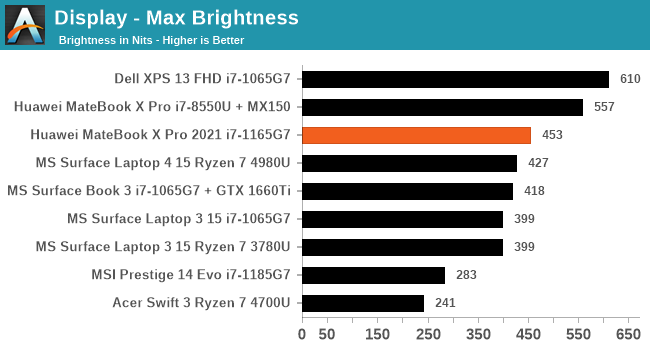
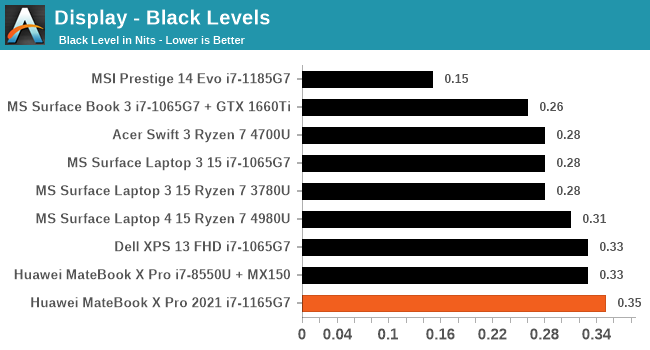
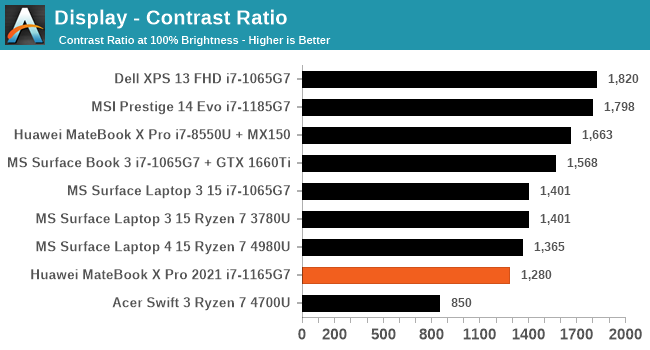
As for maximum brightness, we’re right on specification, however in our testing the black level is certainly higher than other devices in the market, which leads to a lower-than-advertised contrast ratio.
Battery Life
Taking advantage of the bigger-than-13-inch form factor, Huawei has equipped the MateBook X Pro 2021 with a 56 Wh battery, which is about 10-20% bigger than the 45 Wh batteries we see in the smaller size. Without the presence of a discrete GPU, one might argue that this battery should go for a long time, however the high-resolution display might prove to be an Achilles heel. Huawei’s documentation lists a 10 hour battery life for local video playback, which would be just enough for a long haul flight.
For our testing, we calibrate the display as close to 200 nits as we can (in this case, brightness set to 62), and progress through both a movie workload and a web workload. We would have also tested using PCMark’s battery test, however the test would always fail when video decoding, as mentioned previously.
It’s worth noting that Huawei lists the battery as 56 Wh (typical). Our battery reported 55.4 Wh when fully charged.
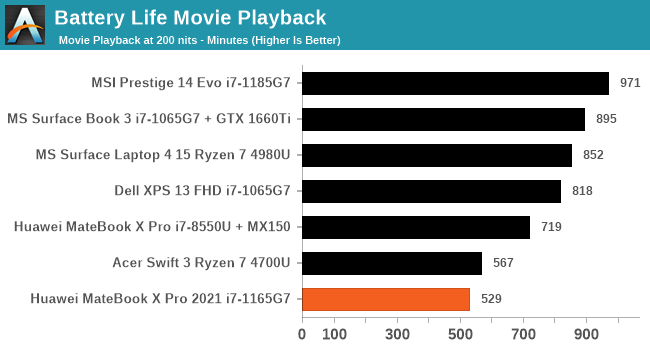
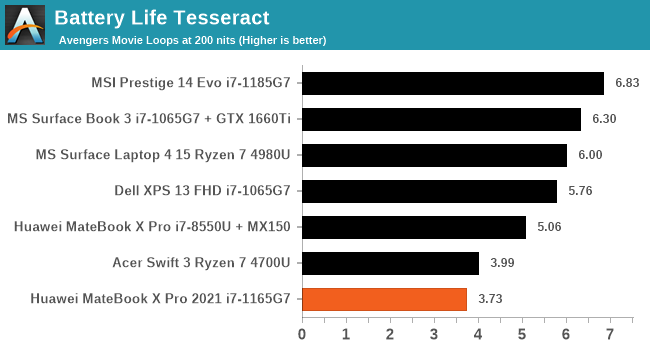
Our movie test at 200 nits is just below the 10 hour mark quoted, however Huawei seems to have done their testing at 150 nits, according to the website. 529 minutes is actually quite low compared to a number of laptops that the MateBook X Pro 2021 competes against.
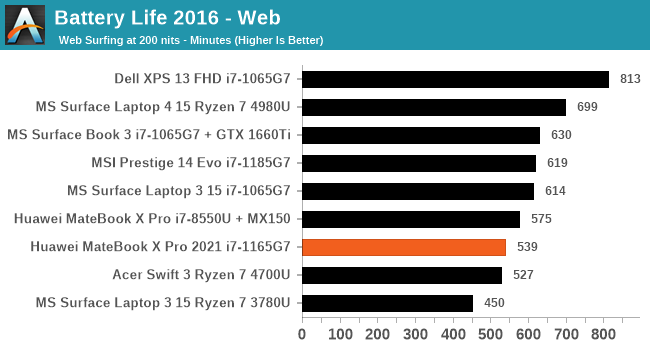
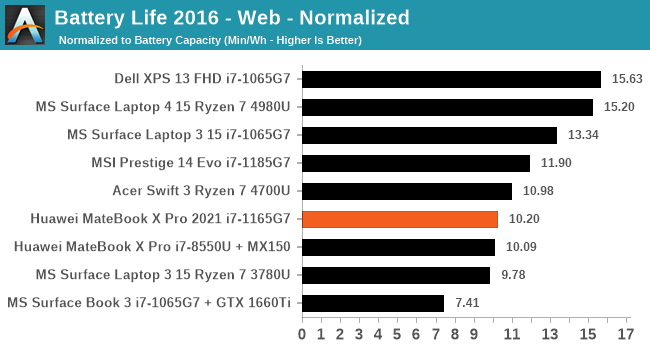
The web test does slightly better than our movie test, even though the screen is doing a lot more whites, but it isn’t having to process so much video. Normalizing for the battery capacity, we get 10.2 minutes per Watt-hour, which again isn’t a great result compared to the previous generation hardware or AMD’s offering.
Charge Time
Huawei ships the laptop with a 65 W charger with a Type-C port, and a C-to-C cable to connect it to the laptop. For our charge test, we discharge the battery down to 5% with a high powered workload, then down to 2% while on idle to cool it down. The system is then plugged it in, set on low power, with the screen still at 200 nits, and then monitored the charge level as reported as a function of time up until the reported charge no longer moved.
As well as our output report, I also put one of these in the loop. It showcased that the laptop was charging around 48-52 W constantly for the first 80 minutes or so, at 20 V / 2.5 A.
For our charge profile, we achieved:
- 2% to 10% charge in 7 minutes
- 2% to 65% charge in 60 minutes
- 2% to 90% charge in 87 minutes
- 2% to 100% charge in 110 minutes
Even though the charger is listed as 65 W capable, I didn’t see it ever go up to 65 W.
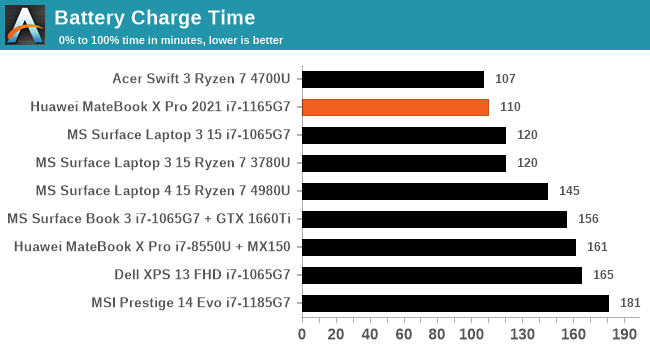


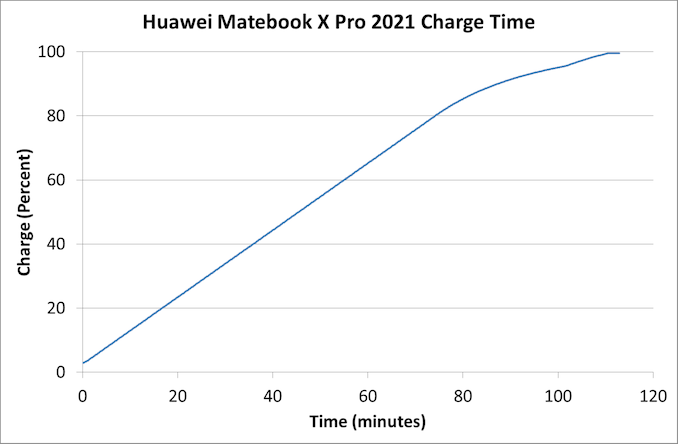








84 Comments
View All Comments
Oliveira_Salazar - Tuesday, September 28, 2021 - link
Very poor review.No direct comparisons with the latest MacBook Air. No M1 mention at all.
It would be extremely easy to include the MacBook Air and/or Pro in a lot if not most of these benchmarks/comparisons. Even the Intel version.
The MBA is the default laptop of this category and everything should be considered against it. Let's not even mention how inspired Huawei is by MBP's designs. You mention that they are trying to place this in a segment where the Macs are their main competition, but don't feature them in any testing at all?
It's pathetic.
This machine is absolutely obliterated performance wise in all metrics. Specially while on battery.
You only make a poor argument that "an equivalent specced Mac is +800$", but "wins on battery life and performance". Is that fair? Is that the whole relevant story? Wouldn't a competent review also include something like "a 500$ to sometimes 600$ cheaper, completely silent MacBook Air beats this in almost all performance metrics and usage scenarios, sometimes by a lot, and wins heavily in battery life too, but only has 8GB of RAM and 256GB of storage, while a version with the same RAM and Storage costs only 100 to 200$ more"
Why isn't there detailed performance testing while on battery power? These are thin and light machines for a reason. It's incredibly low effort to default to a pathetic "browsing test" and "200 nit video playback" to measure battery life.
People use these devices on the road. The default state of all laptops is unplugged. All performance testing should be done by default while on battery, and a separate one while plugged in, all conditions the same, and conclusions should be made.
Unless someone really really needs windows, these laptops should never be recommended at this point. They have are horrific value compared to what an Air offers while on battery.
But people that only read this review wouldn't know.
dontlistentome - Tuesday, September 28, 2021 - link
I'll bite.The MBA is the default laptop of this category - no, it really isn't. If you need to fit into a Windows infrastructure, the default will likely have a HP, Dell or Thinkpad logo on it. Macs are *horrible* to use in a corporate environment. Given their input into the protocol the Thunderbolt implementation is borked (mostly round MST tagging for multiple displays). But then again the MBA can only drive one external panel.
Your price comparisons are **way** out. A Macbook with 16gb/512GB is not $200 more, it is $400 more minimum - the closest comparitor to this is $1450 - $50 less and that's before discounts which don't exist on Apple.
My team has 50+ laptops - mostly Thinkpad X1 Carbon of various gens, some Macs for the off balls. They are used 95% at a desk with power. That's the PCs and Macs (including the M1 Macbooks).
Go off and have a cuddle with your Macbook and feel great about what a genius you are. Meanwhile the rest of the world is still Windows.
lemurbutton - Tuesday, September 28, 2021 - link
I'll bite.The Macbook Air M1 is significantly better than this laptop, and any Windows laptop in its class. Windows itself is less advanced than MacOS. The only thing Windows has that the Mac doesn't is AAA games. That's it. The Mac does everything else better.
Your Thinkpad X1 Carbon sucks compared to M1 Macs.
They should fire you for not buying M1 Macs.
dontlistentome - Tuesday, September 28, 2021 - link
I have both (X1 Gen 9 / MBA M1). Do you?dnanatech - Wednesday, September 29, 2021 - link
I have/had all of those (i7 X1gen6, i7 Matebook XP 2018, M1 MBA), and i7 Latitude 7390.The Mac is significantly better than all 3. X1 has unreliable fingerprint reader, a dim screen, weirdo Fn vs Cntrl key layout (i know it can be re-mapped in BIOS), overheats like a furnace, etc.
Worst of all, all the Windows machine have various battery-performance issues (sleep/hibernate drain, pickiness on chargers, low charging rate, etc), some of which is due to the common OS layer, and some of which is hardware unique to each machine.
It's not limited to these 4 device samples and generation. This goes back many generations to other machines I've had both on Windows side and Apple. Some of the Windows machine are sanitized as corporate-managed devices, and the others I've kept barebone and lean. After a long enough, I have to assume it's the nature of Windows laptops to have battery-related issues.
gescom - Tuesday, September 28, 2021 - link
"Thinkpad X1 Carbon sucks compared to M1 Macs"Please do elaborate.
mmrezaie - Tuesday, September 28, 2021 - link
I had to buy Macbook pro M1, because I needed a laptop and I couldn't find X1 anywhere and lenovo support told me it may take a very long time. M1 laptops are amazing, but X1 is something else. I will still if I had a choice would go X1, just for the keyboard and Linux.Samus - Wednesday, September 29, 2021 - link
My wife had a MBP M1 and returned it after a week. Running legacy applications was like using a Core 2 Duo-era Macbook. And MOST PROGRAMS ARE LEGACY PROGRAMS. I don't think people realize even ADOBE hasn't ported even half their creative suite to M1. And many of the legacy apps have known issues. For example, you can't use Adobe Forms for Acrobat. Literally, the program CANNOT RUN on M1.https://helpx.adobe.com/download-install/kb/apple-...
So unless you exclusively use Apple software and treat the machine like a toy for Safari, Mail and Photos, it's unreliable and the power is wasted.
She went back to using her 2018 MBP and fixed the keyboard that was the problem anyway, and will wait a year or two before revisiting a new Macbook.
mmrezaie - Wednesday, September 29, 2021 - link
Well, I do a lot of data science development and also system software developments. M1 is very good. My grip is with macOS. There are so many quirks I want to do which I cannot, but I could in Linux. On the other hand, macOS has much better support on desktop side compared to Linux.If I could have M1 arm on Linux, ooh that would be one sexy long battery and capable enough muchine.
star-affinity - Saturday, October 2, 2021 - link
”My grip is with macOS. There are so many quirks I want to do which I cannot, but I could in Linux.”Could you mention a few examples of those quriks? Just curios...